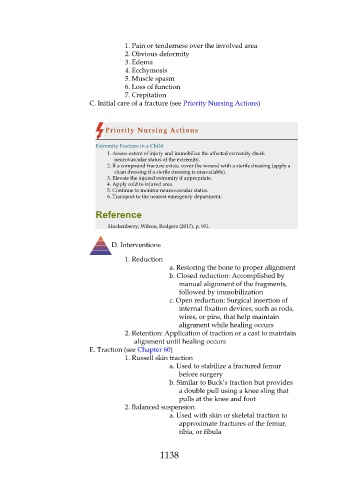Page 1138 - Saunders Comprehensive Review For NCLEX-RN
P. 1138
1. Pain or tenderness over the involved area
2. Obvious deformity
3. Edema
4. Ecchymosis
5. Muscle spasm
6. Loss of function
7. Crepitation
C. Initial care of a fracture (see Priority Nursing Actions)
Priority Nursing Actions
Extremity Fracture in a Child
1. Assess extent of injury and immobilize the affected extremity check
neurovascular status of the extremity.
2. If a compound fracture exists, cover the wound with a sterile dressing (apply a
clean dressing if a sterile dressing is unavailable).
3. Elevate the injured extremity if appropriate.
4. Apply cold to injured area.
5. Continue to monitor neurovascular status.
6. Transport to the nearest emergency department.
Reference
Hockenberry, Wilson, Rodgers (2017), p. 951.
D. Interventions
1. Reduction
a. Restoring the bone to proper alignment
b. Closed reduction: Accomplished by
manual alignment of the fragments,
followed by immobilization
c. Open reduction: Surgical insertion of
internal fixation devices, such as rods,
wires, or pins, that help maintain
alignment while healing occurs
2. Retention: Application of traction or a cast to maintain
alignment until healing occurs
E. Traction (see Chapter 60)
1. Russell skin traction
a. Used to stabilize a fractured femur
before surgery
b. Similar to Buck’s traction but provides
a double pull using a knee sling that
pulls at the knee and foot
2. Balanced suspension
a. Used with skin or skeletal traction to
approximate fractures of the femur,
tibia, or fibula
1138

